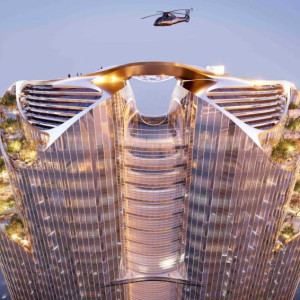Innovative 240-Metre Tower in Egypt to Run on Hydrogen and Solar Power
Key Ideas
- The Forbes International Tower in Egypt plans to run on clean hydrogen and solar energy, aiming for a net-zero carbon footprint and independence from the traditional power grid.
- Materials with low-embodied carbon will reduce the construction's carbon footprint by 58%, and water recycling and treatment will lower freshwater demand in the water-scarce country.
- Exploration of LOHC technology for power generation and hydrogen transportation, potentially utilizing existing fossil fuel infrastructure, is in progress with Schneider Electric and H2 Enterprises.
- An agreement is in place to evaluate the feasibility of utilizing clean hydrogen for the tower's energy needs, with no certainty that hydrogen will be the final power source.
The Forbes International Tower, a 240-meter skyscraper planned in Egypt, is set to be a groundbreaking project powered by hydrogen and solar energy. Designed by Gordon Gill of Adrian Smith + Gordon Gill Architecture and developed by Magnom Properties, the tower aims to achieve a net-zero carbon footprint. The building's 43 floors will be powered by a combination of 75% hydrogen and 25% solar energy generated from panels on its facade, allowing it to operate independently from the traditional power grid. By using materials with low-embodied carbon, the construction process aims to reduce its carbon footprint by 58%. Additionally, on-site water recycling and treatment facilities will help decrease the building's freshwater demand, crucial in Egypt's water-scarce environment. Magnom Properties has partnered with Schneider Electric and H2 Enterprises to explore the use of LOHC technology for power generation and hydrogen transportation. Liquid organic hydrogen carriers (LOHC) can store and transport hydrogen efficiently, potentially repurposing existing fossil fuel infrastructure. While the tower's developers are assessing the feasibility of adopting clean hydrogen for its energy needs, there is no definitive decision yet. This innovative approach showcases a significant step towards sustainable architecture and renewable energy utilization in Egypt.
Topics
Blue Hydrogen
Renewable Energy
Green Technology
Water Conservation
Construction Industry
Carbon Footprint
Sustainable Architecture
Latest News
